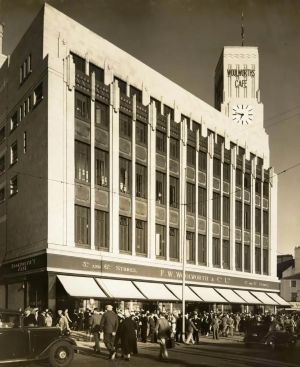 A selection of photographs from the Historic England Archive shows shops, shopkeepers and shoppers in each decade from the 1880s to the 1980s. They illustrate a century of changing shopping habits and shop architecture.
A selection of photographs from the Historic England Archive shows shops, shopkeepers and shoppers in each decade from the 1880s to the 1980s. They illustrate a century of changing shopping habits and shop architecture.
image: Woolworth’s on Bank Hey Street, Blackpool. © Historic England Archive AL2203/003/01
Historic England writes:
1880s
In this 1883 photograph, apron-clad staff pose outside their shop in Soho, London for photographer Henry Dixon.
This shop in the Soho area of London was built in a classical style in the early 18th century. It was demolished around 1886 for the formation of Shaftesbury Avenue.
1890s
Taken on a sunny day in 1896, the Oxford photographer Henry Taunt recorded the front of this sweet shop in the Cotswold town of Chipping Campden.
The shopfront has a bow window and a classical style pedimented doorcase. On display in the shop window are jars of sweets, boxes of confections and advertisements for Fry’s chocolate.
1900s
This 1902 photograph of Miss Emma Clark’s shop in Beaconsfield, Buckinghamshire, includes its proprietress, her elderly mother and three young window shoppers.
Beaconsfield High Street is now known as London End. The building dates from the late 17th century. It illustrates the domestic nature of such a shop on the high street of a small market town at the beginning of the 20th century.
1910s
This photograph taken in 1910 is of York’s famous medieval street, Shambles.
Many of the surviving buildings date to the late 14th and 15th centuries. At the right of this photograph is a butcher’s shop at number 44, which dates to the late 15th century.
The street was formerly full of butchers’ shops and houses, with their own slaughterhouses to the rear. The word ‘shambles’ is thought to derive from the Anglo-Saxon ‘shammel’, describing the shelves that displayed the goods on the shop fronts.
The tradition of the street being full of butcher shops is clear in this image.
1920s
Liberty’s extraordinary shop on Great Marlborough Street in London’s Westminster was constructed in 1922-24. It was a remarkable reaction to the early 20th century vogue for steel-framed buildings dressed in stone.
The store was built of timber from two ships, the Hindustan and Impregnable. Both were broken up during the Admiralty’s post-war economy drive. Liberty’s had been founded in 1875 for the sale of oriental goods and soon branched out into furnishings and clothes.
The original shop was on Regent Street but the firm bought freeholds to the rear and in 1924 opened their new store, designed by architects Edwin T Hall and E Stanley Hall.
Photographed on 3 May 1924, this image was taken for the builders Higgs and Hill by the renowned architectural photography firm Bedford Lemere and Co.
1930s
Photographed around 1938 by Stewart Bale Ltd of Liverpool, Woolworth’s new store at the popular seaside resort of Blackpool was one of the successful chain’s most impressive buildings.
It had three sales floors, and two cafés capable of accommodating over 1,600 diners.
1940s
Outdoor markets continue to play a role in England’s shopping habits. Here, local photographer Hallam Ashley has recorded a busy Norwich Market in the summer of 1948.
A market has been held on this site since the 11th century and it continues to be one of the largest outdoor markets in the country.
After the First World War, the local authority gradually bought each of the stalls with the intention they could be rented by ex-servicemen, and from the 1930s the publicly-owned stalls were arranged in neat parallel rows.
In the early 21st century the stalls were replaced with new ones that have retained their stripey roof motifs. The striped roofs of the stalls have remained a motif of the market to the present day.
1950s
The German-born photographer John Gay was skilled at recording ordinary people at work and at leisure.
In this image from 1956 he took up a position inside a cake shop in Padstow, Cornwall, and captured how a tempting display of cakes delighted a girl and a woman peering through the shop window.
1960s
In typical John Gay style, shoppers have been photographed informally as they look into cages at a pet shop somewhere in the London Borough of Camden.
Exotic birds occupy perches in the centre of the not-so-exotic surroundings. A sign warning of the dangers of touching any of the animals or birds.
1970s
This bold and playful shop entrance decorates the Tyger boutique in the Borough of Kensington and Chelsea.
The inclusion of an elderly woman walking past the shop and the antiques shop in the background suggest that London’s youthful ‘Swinging Sixties’ label had lost its relevance by the mid-1970s.
1980s
Basildon’s Eastgate Centre was built in two phases during the 1980s. Like many town centre, and later off-centre malls, it was designed to protect shoppers from the elements and to separate pedestrian and vehicle traffic.
This view of the central, top-lit atrium was taken in 1986 for its builders, John Laing Group plc.
The indoor shopping centre was built in two phases, the first opening in 1980 and the second in 1985. At the far end of this top-lit mall, flanked on the upper floor with reflective glass, is the multi-storey Allders department store.
Basildon was designated a ‘New Town’ after the Second World War and a Development Corporation formed to transform it into a modern town with all the facilities for a rapidly growing population.
